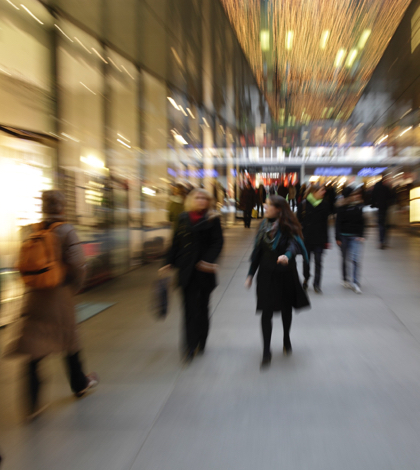Two of country’s major retail trade association are predicting more than a three percent year-over-year increase, in sales, and at least one local mall expects this to be a good year. A better economy and lower unemployment are some reasons for the optimism.
Even though it’s not yet Halloween, much less Thanksgiving, Terri Relf has almost nothing except Christmas on her mind these days.
Relf, senior marketing manager at Inland Center Mall in San Bernardino, is less than two weeks away from welcoming Santa Claus to the mall next to Interstate 215. St. Nick is scheduled to arrive there Nov. 7 – about the same time he’s shown up the last few years – and be there every day until Christmas Eve.
After that, it’s Black Friday, the day after Thanksgiving and the start of the busiest and most crucial four weeks of the year for most retailers.
Inland Center will be open from 6 p.m. to midnight on Thanksgiving, then reopen at 6 a.m. Friday and stay open until 10 p.m. Those hours are a slight break from recent years, when Inland Center opened at 12 a.m. on Black Friday and stayed open into the following evening.
“We’re going to try something a little different this year and see how it works,” Relf said. “We know that no one wants to miss any deals, but we think the change in hours might take some of the pressure off and make things a little easier.
“Not everyone can get out and shop at midnight. This is also a little more in line with what our department stores will be doing.”
Regardless of the schedule, Relf expects the 2015 holiday shopping season to be a good one. The economy is recovering and unemployment is down, which means people will have more money to spend. Also, the possibility of a government shutdown, which seemed very real several months ago, appears to have passed.
“I think we’re going to be fine,” Relf said. “The merchants I’ve spoken with all seem to be confident. I think we’re going to see sales like we do every year, probably about at the same rate as last year.”
Most importantly, the mall itself has had a good year, and a good year usually means a good Christmas.
It’s a little early to predict popular items, but Star Wars toys are a safe bet, as they will be bolstered by the release of “Star Wars: The Force Awakens,” one week before Christmas.
“Star Wars is always popular,’ Relf said. “After that it will be the usual items, like clothing, electronics and jewelry. And I’m sure we’ll see a lot of gift cards.”
The first sign of a healthy Christmas season came back in August, when activity at the ports of Los Angeles and Long Beach picked up, an increase that was attributed mostly to Christmas-related imports.
Following that there was good news on the hiring front. United Parcel Service announced it would hire 95,000 seasonal workers, about 5,000 fewer than last year but still a good number.
Several other major retailers, including Walmart and Macy’s, have announced similar plans, and so far none of those numbers have been revised.
The National Retail Federation in Washington, D.C., is predicting that holiday sales will increase by 3.7 percent compared with 2014, a number that it called “solid.”
That would be a decline from last year, when sales were up 4.1 percent year-over-year, but most retailers would probably settle for it: the retail industry, much of which relies on holiday sales to show an annual profit, considers a three percent year-over-year sales
increase to be a good year.
U.S. consumers are expected to spend $630.5 billion on Christmas gifts this year, and Christmas spending is expected to account for about 19 percent of the U.S. retail industry’s projected $3.2 trillion in sales this year.
The average consumer will spend $805.65 on Christmas gifts this year, essentially unchanged from last year, according to the federation.
And, in a trend that only figures to keep growing, 46 percent of U.S. shoppers said they plan to do all of their “browsing and buying” shopping online, up from 44 percent last year.
Locally, online shopping should continue to grow as well.
“It seems to get a little more popular every year,” Relf said. “Most people like to see what they’re buying, but there are also people who don’t like to leave the house.”
The head of the non-profit federation sounded a cautionary note when assessing this year’s Christmas shopping season.
“We’re heading into the all-important holiday season expecting to see healthy growth,” said Matthew Shay, the federation’s president and chief executive officer, in the organization’s annual holiday forecast released earlier this month. “We expect families to spend prudently and deliberately, though still less constrained than what we saw even two years ago.”
Like the federation, the International Council of Shopping Centers in New York is predicting a year-over-year increase in holiday spending this year, although not as large: up 3.3 percent, with shoppers expected to spend an average of $702.
Gift cards and electronics are expected to be the most popular items, with furniture, clothing and personal care items all expected to post substantial growth. Ninety percent of all U.S. consumers plan to make holiday purchases this year, up from 82 percent last year, according to the council.
Christmas spending usually reflects the state of the economy, which is why the 2015 holiday season should be solid, particularly in the Inland Empire, said regional economist John Husing.
“We’ve had two consecutive quarters of solid growth, and there’s no reason to think it will slow down,” Husing said. “If the economy is good, Christmas is usually good.”
But another local economist isn’t convinced that consumers have moved past the aftershock of the recession and are ready to spend money yet, even on Christmas.
“I think some parts of the country will do well, but in the whole country I don’t think we’re going to see as much spending as some people are predicting” said Jay Prag, professor of economics and finance at the Drucker School of Management at the Claremont Colleges. “On a scale of one to ten, I think we’re looking at a five.”
 IE Business Daily Business news for the Inland Empire.
IE Business Daily Business news for the Inland Empire.


